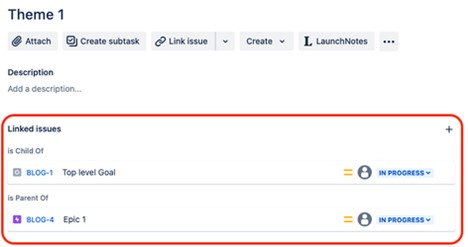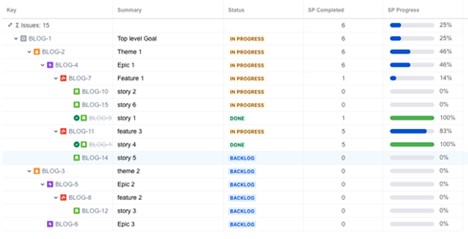Since its inception, Jira has revolved around an agile methodology for software development. SAFe stands out as the leading Scaled Agile Framework, with many of its principles adaptable to Jira. However, Jira’s hierarchy of issue types has become a consistent problem. Since the beginning of both Jira and SAFe, there has been a notable inconsistency in the hierarchy of Jira and its issue types. Those acquainted with SAFe (Scaled Agile Framework) can readily identify the different levels of issue hierarchy:
Goal → Theme → Epic → Capability (optional) → Feature → Story
In standard Jira, however, the issue hierarchy is structured as a three-level system. At the top is the Epic, followed by Standard issue types, which can vary in name, and sub-task type issues at the bottom. This three-level structure is standard in Jira.
These three levels are set in Jira; however, you can incorporate additional layers above the Epic level with tools like Advanced Roadmaps, Easy Agile Programs and BigPicture. The diagram below depicts a typical Jira hierarchy.

The problem is that in traditional configurations, an Epic is not directly the parent of a Story; it often acts as the grandparent or even great-grandparent, which means we need to insert one or two additional layers—namely, Capabilities and Features—to bridge this gap and accurately reflect the issue hierarchy. Jira does not allow this because standard issue types are all flat.
The Typical Align Solution for Jira
To fix the aligning issue that grandparent and great-grandparent Epics cause, some programs, such as Jira Align, state to map Jira Epics to Jira Align Features. The Jira Align mapping is as follows:
This approach, while functional, can be confusing as the term “Epic” may mean something completely different across various tools.
Forty8Fifty’s Epic Solution: Hierarchy for Jira
At Forty8Fifty Labs, we’ve developed a solution to streamline this process. We utilize a combination of native issue linking and the new Hierarchy for Jira – custom issue structure & Jira tree view. With our solution, custom issue structures are viewed in a Jira tree view, creating a clear hierarchy.
Here is a step-by-step procedure to make this work:
- First, set up your “issue types”. Create the following issue types (for simplification purposes, we will not include capabilities in this example).
- Goal
- Theme
- Feature

Epic and Story issue types are already natively created in Jira, so we do not need to recreate them.
2. Next, we must create a new link type, which we will call “Safe Hierarchy”.
-
- Outward: Is Parent Of
- Inward: Is Child Of

3. The third step is establishing the hierarchy by connecting the new issue types. You can do this manually or through automation using the new link type.

This setup ensures that Goals are the parents of Themes. Themes are the parents of Epics. Epics then parent Features, which act as the parents of Stories. This structured linking provides a clear and systematic flow of issues from top to bottom.
4. Next, navigate to the “Hierarchy for Jira – Custom issue structure & Jira tree view” tool and set the Tree Configuration to “Safe Hierarchy
- This adjustment will enable your view to illustrate the correct hierarchy, including useful features such as story point (SP) roll-up and time estimate roll-up.

We understand this setup might seem complex. If you would like help, Forty8Fifty Labs has experts in Agile, SAFe and the entire Atlassian suite. We can help you create your ideal solution.
Related Posts:
Are You Getting the Most Out of Your Jira Instance?
4 Common Mistakes When Moving Your ITSM Solution to Atlassian’s Jira Service Management








